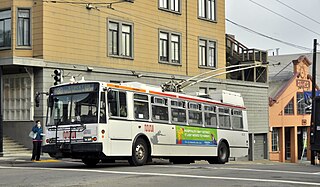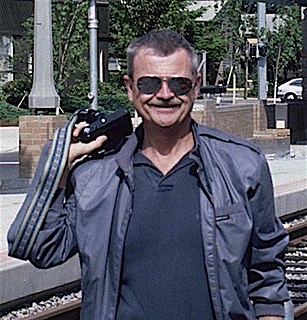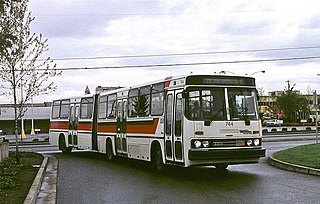Related Research Articles

Awake! is an illustrated religious magazine published every four months by the Watch Tower Bible and Tract Society of Pennsylvania. It is considered to be a companion magazine of The Watchtower, and is distributed by Jehovah's Witnesses. The Watch Tower Society reports worldwide circulation of over 93 million copies per issue in 225 languages.

The Southeastern Pennsylvania Transportation Authority (SEPTA) is a regional public transportation authority that operates bus, rapid transit, commuter rail, light rail, and electric trolleybus services for nearly 4 million people in five counties in and around Philadelphia, Pennsylvania. It also manages projects that maintain, replace and expand its infrastructure, facilities and vehicles.
The General Motors streetcar conspiracy refers to convictions of General Motors (GM) and other companies that were involved in monopolizing the sale of buses and supplies to National City Lines (NCL) and its subsidiaries, and to allegations that the defendants conspired to own or control transit systems, in violation of Section 1 of the Sherman Antitrust act. The suit created lingering suspicions that the defendants had in fact plotted to dismantle streetcar systems in many cities in the United States as an attempt to monopolize surface transportation.
Modern Drummer is a monthly publication targeting the interests of drummers and percussionists. The magazine features interviews, equipment reviews, and columns offering advice on technique, as well as information for the general public. Modern Drummer is also available on the internet.

North American Congress in Latin America (NACLA) is a non-profit organization founded in 1966 to provide information on trends in Latin America and relations between Latin America and the United States. The organization is best known for publishing the quarterly NACLA Report on the Americas, and also publishes "books, anthologies and pamphlets for classroom and activist use". The NACLA Report on the Americas print magazine was briefly discontinued in 2015, but relaunched under the Taylor and Francis imprint Routledge in May 2016.

The Fort Smith Trolley Museum is a streetcar and railroad museum in Fort Smith, in the U.S. state of Arkansas, which includes an operating heritage streetcar line. The museum opened in 1985, and operation of its streetcar line began in 1991. Four vehicles in its collection, a streetcar and three steam locomotives, are listed on the National Register of Historic Places (NRHP). The now approximately three-quarters-mile-long (1.2 km) streetcar line also passes four NRHP-listed sites, including the Fort Smith National Historic Site, the Fort Smith National Cemetery, the West Garrison Avenue Historic District and the 1907 Atkinson-Williams Warehouse Building, which now houses the Fort Smith Museum of History.

The Philadelphia Transportation Company (PTC) was the main public transit operator in Philadelphia, Pennsylvania, from 1940 to 1968. A private company, PTC was the successor to the Philadelphia Rapid Transit Company (PRT), in operation since 1902, and was the immediate predecessor of the Southeastern Pennsylvania Transportation Authority (SEPTA).
The Boston Street Railway Association (BSRA) is a non-profit organization in Boston, Massachusetts, whose central objective is preserving transportation history in Boston and throughout New England. They host monthly membership meetings, publish a bimonthly transit news magazine, and are restoring an ex-Boston Type 5 streetcar. They also regularly publish their own books and materials, as well as organize fan trips on Boston's MBTA and to the Seashore Trolley Museum in Kennebunkport, Maine. Funding for the organization is provided primarily through tax-deductible member and individual donations, as well as through grants and donations from other organizations and groups.

Electric Transit, Inc. (ETI) was a joint venture between the Škoda group in the Czech Republic and AAI Corporation in the United States which made trolleybuses for the Dayton and San Francisco trolleybus systems, constructing a total of 330 trolleybuses. ETI was formed in 1994, and ownership was divided as 65% by Škoda and 35% by AAI. The latter was a wholly owned subsidiary of United Industrial Corporation. Up to that time, Škoda had built more than 12,000 trolleybuses since 1935, but none for cities outside Europe and Asia. The ETI joint venture was dissolved in 2004, shortly after an unsuccessful bid to supply trolleybuses to Vancouver.

The American Vegan Society (AVS) is a 501(c)(3) nonprofit organization that promotes veganism in the United States. It was founded in 1960 by H. Jay Dinshah. The date of the earlier The Vegan Society (UK)'s founding, November 1, is now celebrated annually as World Vegan Day.
In Atlanta, Georgia, trolleybuses, generally called trackless trolleys there, were a major component of the public transportation system in the middle decades of the 20th century, carrying some 80 percent of all transit riders during the period when the system was at its maximum size. At the end of 1949 Atlanta had a fleet of 453 trolleybuses, the largest in the United States, and it retained this distinction until 1952, when it was surpassed by Chicago.
Interurban Press was a small, privately owned American publishing company, specializing in books about streetcars, other forms of rail transit and railroads in North America, from 1943 until 1993. It was based in the Los Angeles area, and specifically in Glendale, California after 1976. Although its primary focus was on books, it also published three magazines starting in the 1980s, along with videos and calendars. At its peak, the company employed 10 people and generated about $2 million in business annually.

George McClelland Sebree III, better known as Mac Sebree, was an American journalist, writer and publisher whose area of expertise was urban mass transit, particularly urban rail transit. He was also a businessman, being owner and president of the publishing company, Interurban Press, from 1975 until 1993. In addition to writing and publishing historical material, he also followed – and regularly reported on – contemporary developments concerning rail transit, and by the 1990s he had become an expert on light rail in North America.

The American Bus Association (ABA) is a trade association for motorcoach operators and tour companies in the United States and Canada. Its membership consists of about 1,000 companies that operate buses or bus-based tours, about 2,800 organizations representing the travel and tourism industry, and several hundred suppliers of buses and related products and services. Its headquarters is in Washington, D.C.

The New Electric Railway Journal was a quarterly American magazine primarily about electric urban rail transit in North America, published from 1988 to 1998, with an international circulation. Its name was a tribute to a much earlier magazine with similar coverage, the Electric Railway Journal, established in 1884 and published until 1931.

The San Francisco trolleybus system forms part of the public transportation network serving San Francisco, in the state of California, United States. Opened on October 6, 1935, it presently comprises 15 lines, and is operated by the San Francisco Municipal Railway, commonly known as Muni, with around 300 trolleybuses. In San Francisco, these vehicles are also known as "trolley coaches", a term that was the most common name for trolleybuses in the United States in the middle decades of the 20th century.

The Seattle trolleybus system forms part of the public transportation network in the city of Seattle, Washington, operated by King County Metro. Originally opened on April 28, 1940, the network consists of 15 routes, with 174 trolleybuses operating on 68 miles (109 km) of two-way overhead wires. As of spring 2016, the system carries riders on an average of 73,200 trips per weekday, comprising about 18 percent of King County Metro’s total daily ridership. At present in Seattle, a very common alternative term for trolleybus is trolley.

The Dayton trolleybus system forms part of the public transportation network serving Dayton, in the state of Ohio, United States. Opened on April 23, 1933, it presently comprises seven lines, and is operated by the Greater Dayton Regional Transit Authority, with a fleet of 54 trolleybuses.

The Philadelphia trolleybus system forms part of the public transportation network serving Philadelphia, in the state of Pennsylvania, United States. It opened on October 14, 1923, and is now the second-longest-lived trolleybus system in the world. One of only five such systems currently operating in the U.S., it presently comprises three lines, and is operated by the Southeastern Pennsylvania Transportation Authority (SEPTA), with a fleet of 38 trolleybuses, or trackless trolleys as SEPTA calls them. The three surviving routes serve North and Northeast Philadelphia and connect with SEPTA's Market–Frankford rapid transit line.

The Crown-Ikarus 286 is a type of transit bus that was manufactured for the U.S. market from 1980 until 1986, under a joint venture between the Ikarus Body and Coach Works (Ikarus), of Budapest, Hungary, and Crown Coach Corporation from Los Angeles, California in the United States. Loosely based on the Ikarus 280, the Crown-Ikarus 286 is a high-floor articulated bus.
References
- 1 2 3 4 5 Stewart, Bill (October 2, 2000). "Motor Bus Society members will go all through the town for convention" . The Oregonian . Portland, Oregon. p. B4 – via NewsBank.
- ↑ MBS Contact Information. Motor Bus Society. Retrieved 2010-08-28.
- 1 2 3 4 5 "50 Years of the Motor Bus Society". Motor Coach Today, January–March 1998, p. 2.
- ↑ The John P. Hoscheck Memorial Bus Transportation Archives. Motor Bus Society. Retrieved 2010-08-28.
- ↑ The Motor Bus Society. Retrieved 2010-08-28.
- ↑ Motor Coach Age & Motor Coach Today Index, 1950–2006 (PDF). Motor Bus Society. September 30, 2006. Retrieved 2010-08-28.